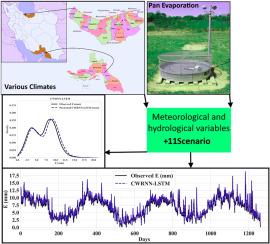Prediction of pan evaporation across diverse climates and scenarios using temporal attention clockwork recurrent neural networks coupled with long short-term memory
IF 8.7
Q1 Environmental Science
引用次数: 0
Abstract
Accurate prediction of evaporation is crucial for effective water resource management, particularly in regions facing water scarcity. This study investigates evaporation dynamics at two distinct locations with different climates in Iran (Minab and Ramsar stations) using machine learning methods, including simple Recurrent Neural Network (RNN), Long Short-Term Memory (LSTM), ClockWork Recurrent Neural Network (CWRNN), Hybrid temporal attention RNN-LSTM, and CWRNN-LSTM models under 11 different scenarios. Our key findings include: (1) the temporal attention CWRNN-LSTM model achieved R2 values of 0.982 at Minab and 0.985 at Ramsar, indicating a strong correlation between predicted and observed evaporations; (2) the model produced low Root Mean Square Error (RMSE) values of 0.412 and 0.255, respectively, reflecting its high accuracy; and (3) compared to conventional standalone models, the hybrid models improvemed R2 by up to 32.4% and reduced RMSE by 65.7%. By capturing underlying trends and variations in evaporation dynamics, the temporal attention CWRNN-LSTM model could serve as a robust tool for improving water resource management strategies.

利用时间注意发条递归神经网络结合长短期记忆预测不同气候和情景下的蒸发皿蒸发量
准确预测蒸发量对于有效的水资源管理至关重要,特别是在面临缺水的地区。本研究利用机器学习方法,包括简单递归神经网络(RNN)、长短期记忆(LSTM)、ClockWork递归神经网络(CWRNN)、混合时间注意(RNN -LSTM)和CWRNN-LSTM模型,研究了11种不同情景下伊朗两个不同气候地点(Minab站和Ramsar站)的蒸发动态。主要发现包括:(1)CWRNN-LSTM模型在Minab和Ramsar的时间关注R2值分别为0.982和0.985,表明预测蒸发量与观测蒸发量具有较强的相关性;(2)模型的均方根误差(RMSE)较低,分别为0.412和0.255,具有较高的准确性;(3)与传统的独立模型相比,混合模型的R2提高了32.4%,RMSE降低了65.7%。通过捕捉蒸发动力学的潜在趋势和变化,CWRNN-LSTM模型可以作为改进水资源管理策略的有力工具。
本文章由计算机程序翻译,如有差异,请以英文原文为准。
求助全文
约1分钟内获得全文
求助全文
来源期刊

Water Cycle
Engineering-Engineering (miscellaneous)
CiteScore
9.20
自引率
0.00%
发文量
20
审稿时长
45 days
 求助内容:
求助内容: 应助结果提醒方式:
应助结果提醒方式:


